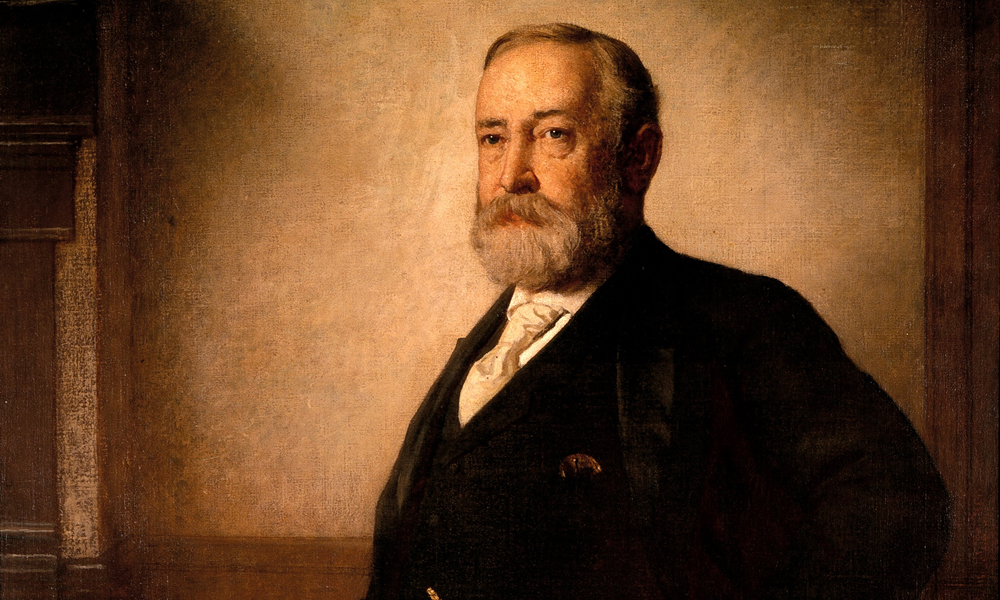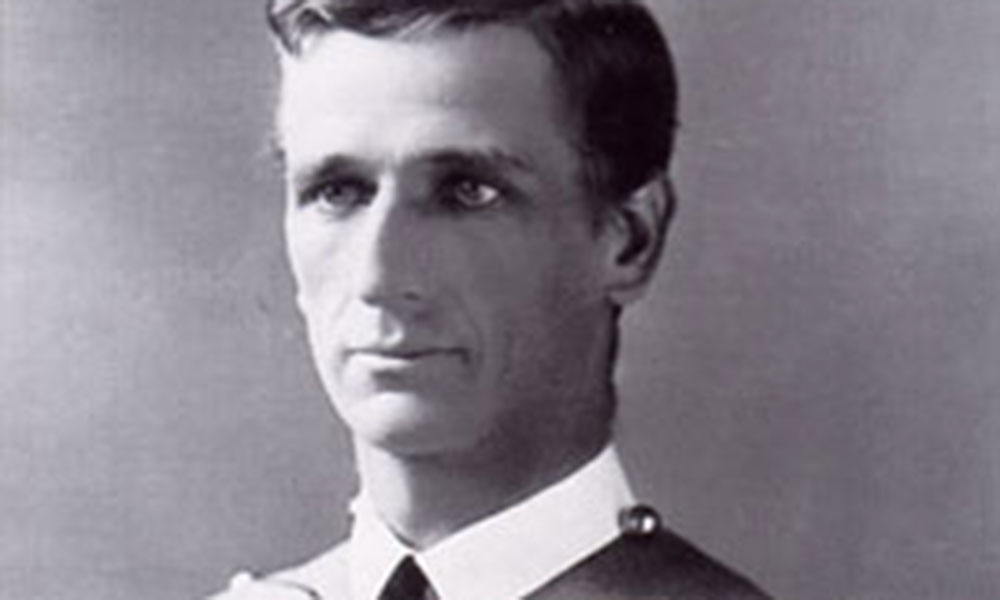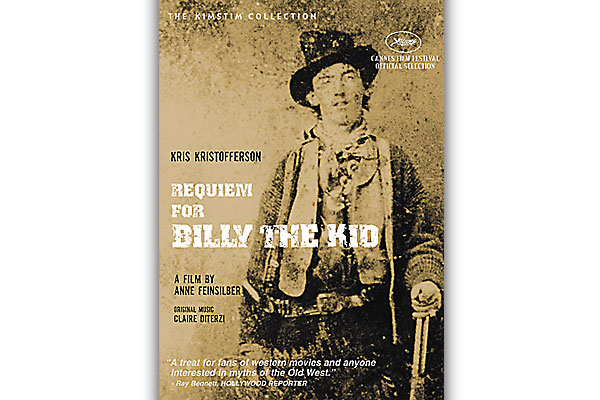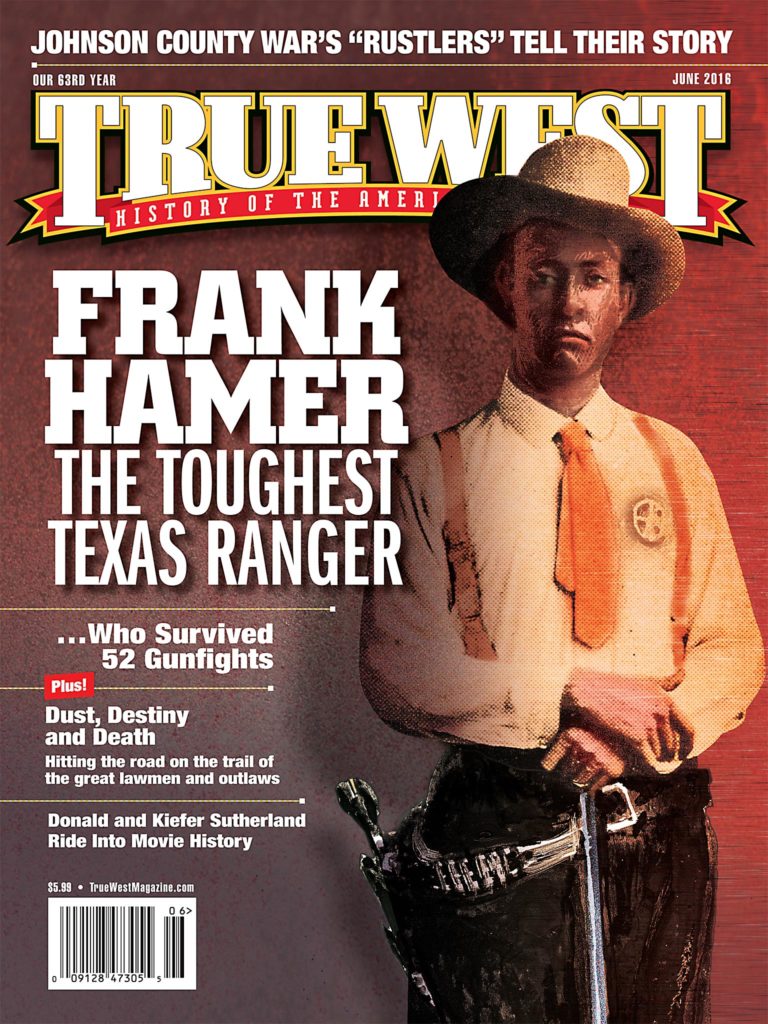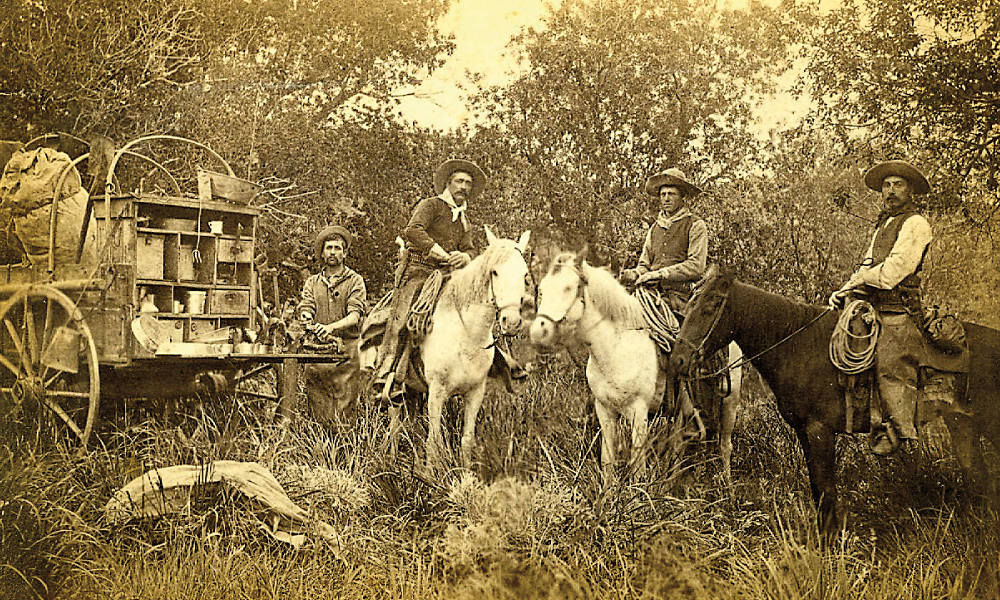
– Courtesy Johnson County Library –
Nick Ray stepped outside the cabin into the morning light, looking for Ben Jones and Billy Walker. Seeing no sign of his cabin mates, Ray turned to walk back. A shot rang out.
Ray, wounded, dropped to the ground. As bullets whistled around Ray, Nate Champion rushed from the cabin, shooting at the hidden assailants. Reaching Ray, Champion helped him into the cabin. Thus, on April 9, 1892, began a major chapter in Wyoming’s Johnson County War.
Disputes Among Cattlemen
Land disputes are old news in the American West. Land has been a flashpoint from the first contact between frontiersmen and American Indians up to today, when some individuals, perceiving entitlement to the range, pit themselves against what they view as federal government-licensed cattle rustling. The Johnson County War was a major flare-up in this age-old smoldering fire.
With the Union Pacific Railroad reaching Cheyenne, Wyoming, in 1867, the cattle industry boomed. The Wyoming Stock Growers Association became a powerful political organization that attracted wealthy cattle barons. Wyoming achieved statehood on July 10, 1890, with Cheyenne becoming the capital and the Association controlling its government.
The lush grass of the open range along the eastern foothills of Big Horn Mountains was well suited for beef cattle. Cattlemen brought herds to Johnson County with the building of Fort McKinney in 1878. Nearby Buffalo grew into Johnson County’s most important town and became county seat in 1881. Large ranching operations, as well as homesteading ranches, ran cattle.
Cattle roamed the open range unrestricted, making it necessary to brand them to determine ownership. During roundups, ranch hands branded calves and unmarked animals called mavericks. Cattlemen hired stock detectives to bring rustlers to justice, but historians have found little evidence of livestock theft in the early days of Johnson County.
In 1884, the Wyoming Legislature passed the Maverick Law, which gave the Association all mavericks and unbranded calves, and the right to determine who owned the animals. “Ranchers who asserted their right to gather mavericks from their own herds and mother cows were now rustlers,” says Earl Madsen, present-day owner of the T.A. Ranch.
The cattle barons blamed any diminishing of their herds on rustlers instead of on droughts, predators, blizzards and overgrazing. They sought land and water claims on ranges they considered theirs. To secure these rights, they set about accusing rustling by homesteading ranchers and even by their own cowboys who owned personal livestock.
Association members began forbidding employees to own cattle. They excluded homesteading ranchers from the Association and from roundups. Johnson County citizens saw the Association’s actions as attempts to drive homesteading ranchers from the open range granted to them under the federal Homestead Act and Desert Land Act.
In 1889, Johnson County juries failed to convict persons accused of rustling in five separate cases, which infuriated the cattle barons. The jury members had seen the evidence as flimsy at best.
That same year, cattlemen lynched Carbon County homesteaders Ellen “Cattle Kate” Watson and Jim Averell, who they accused of rustling. In 1891, three men working for the Association hanged Thomas Waggoner, a horse trader.
Next, the Association attempted to kill Johnson County homesteading rancher Champion, an outspoken Association critic. No evidence tied him to rustling, but the Association believed he must be stealing cattle. On November 1, 1891, they sent five men to kill him.
Champion escaped death. He killed one of his would-be murderers and identified another assailant as Association stock detective Joe Elliott. John Tisdale and Orley “Ranger” Jones were ready to testify in court that Elliott and others had attacked Champion, but before they could do so, they were murdered.
On February 8, 1892, Johnson County district court held a preliminary hearing on Elliott’s attempt on Champion’s life. Elliott remained in jail.
Homesteading cattlemen formed the Northern Wyoming Farmers’ and Stock Growers’ Association, announcing its own roundup, which would take place on May 1, 1892, one month before the Association’s roundup. They appointed Champion foreman and mocked the Association by calling themselves “Rustlers.”
The Association had enough; it was time to get rid of the rustlers. Members especially worried Elliott would break and identify them as the men behind the assassination attempt on Champion.
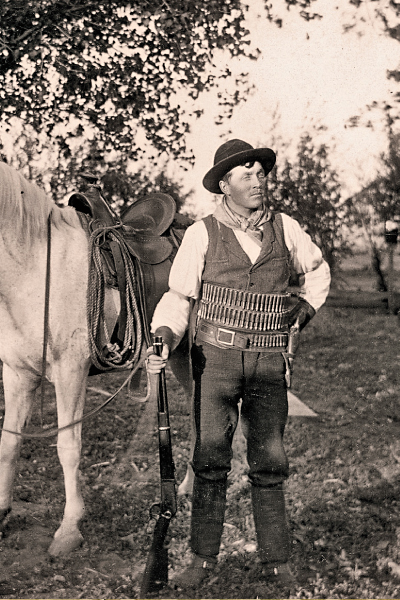
– Courtesy Heritage Auctions, October 25, 2015 –
Planning an Invasion
While smoking cigars, sipping brandy and playing billiards in the posh Cheyenne Club, Association members plotted to invade Johnson County and kill the rustlers and their supporters. Major Frank Wolcott drafted invasion plans. One hundred Association members contributed $1,000 each. Stock detective Tom Smith traveled to Texas where he hired 26 gunmen. The Association bought 52 horses, three freight wagons, guns, ammunition and dynamite.
Governor Amos Barber knew about the planned invasion. On March 23, he sent a telegram to Wyoming National Guard commanders to disobey orders from county sheriffs.
The invaders invited Ed Towse, a reporter with the Cheyenne Daily Leader, who had told the cattleman’s side of Cattle Kate’s hanging, and Sam Clover, of the Chicago Herald. Clover promised to tell the Association’s version of the story to a national audience.
Frank Canton, a stock detective and former Johnson County sheriff, and others developed a death list that named 70 men to kill, including Johnson County Sheriff W.E. “Red” Angus, his deputies, three county commissioners and Buffalo Bulletin newspaper editor Joe DeBarthe.
Nineteen Association conspirators met a chartered train from Denver, Colorado, that was carrying supplies and the 26 Texan gunmen, each promised $5 per day, expenses, a $3,000 accident policy and $50 for every dead rustler. The train left Cheyenne, Wyoming, on April 5, with 52 Association members, employees, Texan gunmen and guests.
Attacking the “Rustlers”
At four a.m., the invaders arrived in Casper, where they began their 150-mile ride north, through a blizzard and gumbo mud, to fulfill their murderous mission.
Following Wolcott’s instructions, E.T. David, ranch manager for Sen. Joseph Carey, cut the telegraph lines to Buffalo so that townspeople could not request help.
Riding toward Buffalo, the invaders learned Champion was at the KC Ranch and voted to kill him first. Eliminate Champion, and the case against Elliott would evaporate.
The invaders reached the KC Ranch the night of April 8. The next morning, they captured two trappers who had stopped to stay the night, Jones and Walker. When Ray left the cabin to see where the men had gone, Wolcott nodded to “Texas Kid” (possibly C.D. Brooks), who fired a shot that struck Ray. With the help of Champion, Ray made it back to his cabin, where he died. Champion put up a stiff defense, wounding three attackers.
Jack Flagg and his stepson Alonzo Taylor rode by on the road to Buffalo. The invaders recognized Flagg as one of the men on the death list. They opened fire, and 10 men chased them. The two eluded their pursuers and rode to Buffalo to sound the alarm.
The invaders pushed a burning wagon against the cabin, smoking out Champion, who, charging out of the building, died in a hail of bullets. After killing Champion, the invaders advanced toward Buffalo.
A County Arms for Battle
Alerted by Flagg and Taylor, Sheriff Angus organized a posse that grew to roughly 400 men. The “rustler” ranchers rode out of Buffalo to confront the invaders.
Informed by outriders that a posse’s camp was to their front, the invaders decided to fortify themselves 14 miles south of Buffalo in the house and barn at the T.A. Ranch. When the posse reached the T.A. Ranch, the ranchers surrounded the invaders. Shooting was continuous between both sides.
The desperate invaders needed help. During the night, one invader sneaked out with a message. Riders carried his message 100 miles to Douglas, where it was sent by telegram to Gov. Amos Barber who sent it to President Benjamin Harrison, requesting federal troops to quell the “insurrection.” Harrison was sleeping, and no one dared wake him.
Barber then sent the telegram to Wyoming Sen. Frances E. Warren, an Association member, and Joseph Carey, former Association president. They traveled to the White House and woke Harrison who agreed to send troops to rescue the invaders. When his telegram reached Fort McKinney, the 6th Cavalry set out.
Meanwhile back at the ranch, the posse had captured the invaders’ wagons. Using the running gears, the men built a protective device they named the “go-devil.” They were advancing behind it to get within range so they could toss the invaders’ own dynamite at them. The cavalry arrived just in time to save the invaders.
Colonel J.J. Van Horn negotiated with Sheriff Angus to allow the invaders to surrender to federal troops. Angus agreed, so long as the invaders would be handed over later to civilian authorities. The troops marched the invaders to Fort McKinney, then escorted them to Cheyenne, where they were eventually released. They never stood trial.
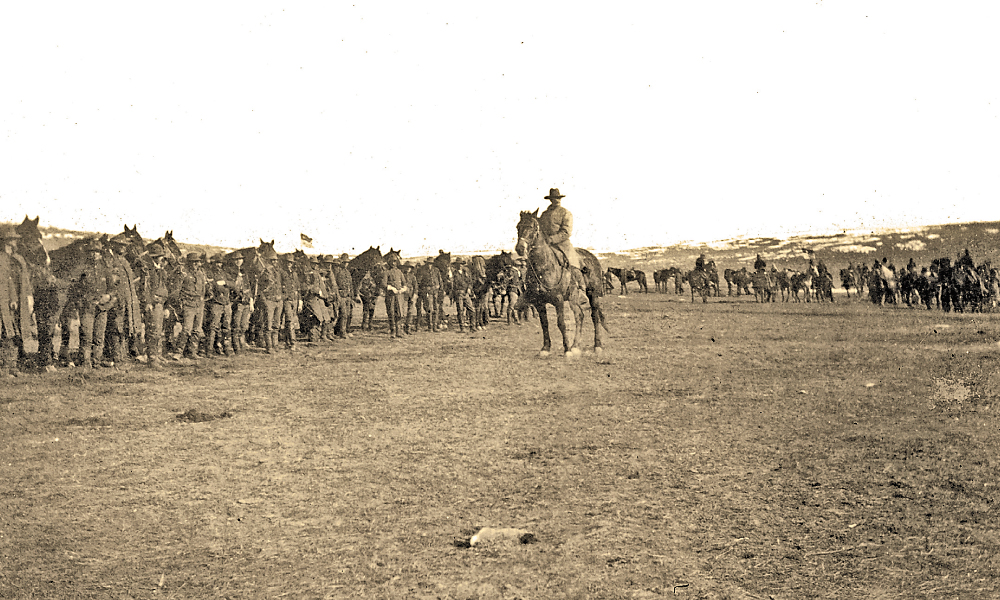
– Courtesy Wyoming State Archives, 21993 –
Incensed Wyomingians
Wyoming never brought charges against the invaders; Johnson County did, but the invaders’ attorneys stalled in court until Johnson County ran out of money and had to drop the case.
At the time of the Johnson County War, Sen. Warren and fellow Association members had been attempting to transfer federal lands to the Wyoming state government where they believed they could control its use. Outrage over the invasion turned public opinion against Warren’s land transfer proposals. Ranchers could not acquire federal property owned by the government; federal land would remain in federal control.
Johnson County citizens are still wary of Cheyenne. Sometimes in the area, you can find a car with a bumper sticker reading, “Johnson County: We Haven’t Trusted Cheyenne since 1892.”
Bill Markley thanks Earl and Barbara Madsen of the TA Ranch, Megan Herold of the Johnson County Library, and Loren and Bev Leichtnam for their assistance in researching this article. Visit BillMarkley.com to learn about Markley’s writing.


